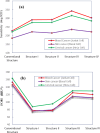On the sensing performance improvement in SPR biosensor using ZnO and TMDCs architecture for cancer detection
- PMID: 40760096
- PMCID: PMC12322250
- DOI: 10.1038/s41598-025-14131-8
On the sensing performance improvement in SPR biosensor using ZnO and TMDCs architecture for cancer detection
Abstract
In this study, we have unveiled an SPR biosensor for highly sensitive and rapid detection of cancerous cells employing 2D materials. The proposed sensor structure introduces a novel approach to cancer cell detection, offering a new perspective in biosensing technology. In other words, specifically, ZnO, Si3N4 and TMDCs based plasmonic sensor structures demonstrate great potential whenever high-accuracy detection of cancerous cells is required. We present four different configuration of SPR based sensor designed for the detection of different types of cancer cells. The designed conventional configuration consists of four functional layers namely Ag, ZnO, Si3N4 and sensing medium along with BK7 prism for coupling light at the interface of metal-dielectric. To illustrate performance improvement, enhancement of light absorption capacity and achieve higher sensitivity of sensor, we incorporated four different 2D materials, MoS2, MoSe2, WS2 and WSe2. Using the angular interrogation method, the proposed layered structure, BK7/ZnO/Ag/Si3N4/WS2/sensing medium, demonstrated the highest overall sensitivity in terms of detecting three cancerous cells, blood cancer (Jurkat), cervical cancer (HeLa) and skin cancer (Basal) from healthy cells. Notably, the sensitivity which is achieved with the configuration BK7/ZnO/Ag/Si3N4/WS2/sensing medium for blood cancer detection from healthy cells with the value of 342.14 deg/RIU and FOM equal to 124.86 RIU-1, outperforms all other proposed configurations. Applying finite element method (FEM) simulations, the distribution of electric field across the interfaces of the SPR sensor configurations are analyzed. Overall, SPR biosensors offer a promising technology for the early and accurate cancerous cell detection. The high sensitivity, specificity, and ability to analyze complex biological samples make them valuable tools in the struggle against cancer. However, further research and development are demanded to optimize the performance and translation of these sensors into clinical and real-world applications.
Keywords: Biosensor; Cancer detection; SPR; Sensitivity; TMDCs; ZnO.
© 2025. The Author(s).
Conflict of interest statement
Declarations. Competing interests: The authors declare no competing interests.
Figures










Similar articles
-
Mathematical modeling of surface plasmon and detection of DNA hybridization using novel SPR sensor.Biosens Bioelectron. 2025 Nov 1;287:117753. doi: 10.1016/j.bios.2025.117753. Epub 2025 Jul 3. Biosens Bioelectron. 2025. PMID: 40628023
-
Design of a plasmonic optical biosensor based on a metal-insulator-metal ring resonator for the detection of various bacterial pathogens.Sci Rep. 2025 Jul 1;15(1):20699. doi: 10.1038/s41598-025-07331-9. Sci Rep. 2025. PMID: 40596579 Free PMC article.
-
Robust Plasmonic Structures Fabricated by Femtosecond Laser-Assisted Anisotropic Intaglio Engraving on Quartz for High-Sensitivity Surface Plasmon Resonance Sensing.ACS Appl Mater Interfaces. 2025 Jun 18;17(24):36121-36135. doi: 10.1021/acsami.5c02734. Epub 2025 Jun 6. ACS Appl Mater Interfaces. 2025. PMID: 40476590
-
The effect of sample site and collection procedure on identification of SARS-CoV-2 infection.Cochrane Database Syst Rev. 2024 Dec 16;12(12):CD014780. doi: 10.1002/14651858.CD014780. Cochrane Database Syst Rev. 2024. PMID: 39679851 Free PMC article.
-
Trends and Challenges of SPR Aptasensors in Viral Diagnostics: A Systematic Review and Meta-Analysis.Biosensors (Basel). 2025 Apr 12;15(4):245. doi: 10.3390/bios15040245. Biosensors (Basel). 2025. PMID: 40277558 Free PMC article.
References
-
- Soni, G. K., Manhas, P. & Sharma, R. K. Peptide-based optical biosensors: a promising approach for early-stage cancer detection. Biosens. Bioelectronics: X. 12, 100259 (2022).
-
- Du, Y. et al. Breast cancer early detection by using Fourier-transform infrared spectroscopy combined with different classification algorithms. Spectrochim. Acta Part A Mol. Biomol. Spectrosc.283, 121715 (2022). - PubMed
-
- Xiao, G. et al. Light-addressable photoelectrochemical sensors for multichannel detections of GPC1, CEA and GSH and its applications in early diagnosis of pancreatic cancer. Sens. Actuators B. 372, 132663 (2022).
-
- Schiffman, J. D., Fisher, P. G. & Gibbs, P. Early detection of cancer: past, present, and future. Am. Soc. Clin. Oncol. Educational Book.35 (1), 57–65 (2015). - PubMed
-
- Yasli, A. Cancer detection with surface plasmon resonance-based photonic crystal fiber biosensor. Plasmonics16, 1605–1612 (2021).
MeSH terms
Substances
LinkOut - more resources
Full Text Sources
Medical

